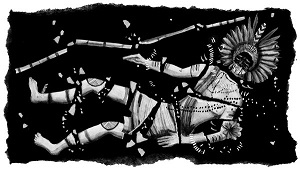FRIENDS and family gathered around the limp body of a 15-year-old boy laid out on a bed in a thatched hut near the Brazilian town of Iguatemi, close to the border with Paraguay. A shaman shook a small wooden rattle while chanting and dancing — final rites for yet another victim of a suicide epidemic that has plagued the Guaraní Indians of the western Brazilian state of Mato Grosso do Sul.
The boy, Dedson Garcete, had hanged himself — one of 36 suicides among tribe members in 2014 through September, and one of about 500 among the tribe of 45,000 since 2004, according to Zelik Trajber, a pediatrician with the special secretariat for indigenous health within the Ministry of Health in Mato Grosso do Sul.
Indigenous peoples suffer the greatest suicide risk among cultural or ethnic groups worldwide. Australian Aboriginal and Torres Strait Islander men ages 25 to 29 have a suicide rate four times higher than the general population in that same age group in Australia, according to the country’s Department of Health.
In the United States, suicide is the second leading cause of death, behind accidents, for American Indian and Alaska Native men ages 15 to 34, and is two and a half times higher than the national average for that age group, the Centers for Disease Control and Prevention reports.
Among the indigenous in Brazil, the suicide rate was six times higher than the national average in 2013, according to a study released in October by Brazil’s Ministry of Health. That translates into 30 suicides per 100,000 people. Among members of the Guaraní tribe, Brazil’s largest, the rate is estimated at more than twice as high as the indigenous rate over all, the study said.
In fact it may be even higher. The Indigenous Missionary Council says there were over 70 suicides in 2013, substantially more than the figure of 49 provided by Dr. Trajber.
The Guaraní have long made their home in the fertile land of Brazil’s southwest, where swaths of vast forests and savannas have been transformed into farms and ranches. In the process, the tribe has been dispossessed and uprooted from its traditional way of life. Many in the tribe face extreme discrimination and live in abject poverty close to the farmers and ranchers who occupy land that was once theirs.
“Living in this nonplace, they commit suicide,” said Maria de Lourdes Beldi de Alcantara, an anthropologist at the University of São Paulo who for years has studied adolescent suicides among the Guaraní.
Nearly 100 years ago, the Guaraní, who today live primarily in Brazil and Paraguay, were forced off their ancestral land when the Brazilian government granted farmers and ranchers the legal title to that land. Tribe members were placed in crowded reservations, and often separated from family members.
Then, in 1988, the Brazilian government created a new Constitution that established rights for indigenous people. Among them: giving Guaraní and other indigenous families the right to repossess their ancestral land, a process that has been slow and frustrating for both Indians and farmers and that has put them even more at odds.
In many cases, farmers, too, have lived in Mato Grosso do Sul for generations. They raised their families there, and worked and profited from the land, first from maté (a kind of tea), and later from sugar cane and soybeans. Like the Guaraní, they are rooted in the land, making the conflict between landowners and the Guaraní both cultural and material. Where the indigenous see repossession of their ancestral land as integral to revitalizing their cultural traditions and regaining their sense of well-being, ranchers and farmers view it as a hindrance to Brazilian progress and development.
James Anaya, the United Nations special rapporteur on the rights of indigenous peoples from 2008 to last May, said suicides among indigenous youth, across the globe, are common in situations where tribe members have seen the upheaval of their culture, which produces in the indigenous a lack of self-confidence and grounding about who they are.
In the southwest of Brazil, he said, distress, poverty and violence against tribal leaders have led to despair among Guaraní teenagers, who feel they don’t have a future. “They see taking their own lives as unfortunately and sadly an option,” he said.
Professor Alcantara said that over the past 10 years tribe members have come to live between two cultures — the culture of nearby cities, where they are discriminated against, and the culture of their own tribe. Young tribe members, in particular, feel that they don’t belong either to the city or to the tribe, she said.
Tonico Benites, a Guaraní and anthropologist, said that during Brazil’s dictatorship of the 1970s and ’80s, conditions on Guaraní reservations deteriorated: There was overcrowding and families were split apart. Today, the situation has grown even worse, he said, and many Guaraní feel lonely and isolated.
“At some point, many people I knew, friends, had lost their autonomy, their way of supporting themselves,” he said. “So they end up thinking about death.”
Off the reservation, Guaraní have suffered extreme prejudice, threats and worse, Dr. Benites said. “It happened to me three times, when I was waiting on the side of the road and a truck came at high speeds toward me,” he recalled. “I had to jump, otherwise it would have hit and killed me … and later they’d say it’s an accident, but it isn’t.”
He said pistoleros hired by farmers have burned Guaraní huts, tortured his friends and killed tribal leaders.
Mr. Anaya, a law professor at the University of Arizona, said he believes that improving educational systems for the Guaraní and other indigenous groups can help. “We need education that doesn’t try to take out of indigenous children their identity but rather helps to reinforce it with all the modern tools that are appropriate to modern life,” he said.
Both sides want a peaceful solution, but in small Guaraní villages across Mato Grosso do Sul, Guaraní boys like Dedson continue to despair.
“Our biggest hope, for which we struggle every day,” Dr. Benites said, “is that our children may be happier in the future. That one day they can live another kind of life, a better one.”













































